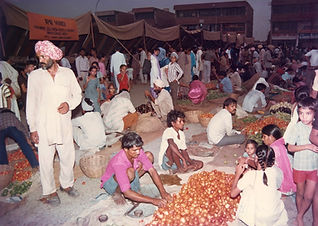“Our heads are screwed on forward for a reason.
We are not meant to look backwards continually.”

Electronic Voting Machines
To address frauds and simplify the electoral procedure, the Election Commission of India (ECI) introduced Electronic Voting Machines (EVMs) in the late 1990s. A serious concern with the use of paper ballots in India was booth-capturing where party loyalists would occupy a polling booth by force and stuff the ballot box with fake ballots. EVMs were designed to discourage such fraud by limiting the rate of casting votes to five per minute. This feature increased the time required to cast false ballots, providing a larger time-frame for security forces to arrive and intervene. There is also a “close” button to disable the device in the event that a polling booth is captured by force. Greater transparency is created by the fact that electronic voting signatures and thumb impressions are maintained in a register open to public inspection, which is in contrast to paper balloting where inspection took place only under court orders and where the validity of any ballot was determined at the discretion of an election officer.
During his tenure as Chief Election Commissioner, Dr. Gill conducted three Parliamentary Elections in 1996, 1998 and 1999, along with elections to numerous State Legislatures. He also conducted elections for President and Vice-President of India in 1997. Electronic Voting Machines (EVMs) were introduced for the first time. During 1998-2000, the entire electoral roll was computerised and Photo Identity Cards were promoted. It was under his stewardship, that the Commission won international recognition and its members were invited to provide expertise and technical assistance to countries such as Nigeria, Indonesia, Cambodia, South Africa, amongst others.


Agricultural Cooperatives
Dr. Gill qualified in the Indian Civil Services Examination with distinction. He worked extensively on rural development, agriculture improvement and literacy improvement. He is credited with introducing the cooperative credit banking system for farmers.
In recognition of his work in these areas, he was selected to represent the Indian Administrative Service nationally and sent to Queens' College, Cambridge, for a one-year Development Studies Programme. He became the Managing Director, National Cooperative Development Corporation, wherein he oversaw the Cooperative Movement in all the states of the Indian Union. He was invited by the World Bank to head one of their largest projects (SADP or Sokoto Agricultural Development Programme, 500 million dollars over five years) in Nigeria. He went on to serve as the Development Commissioner of Punjab, and later, as Agriculture Secretary in the Government of India from 1985-1987.
Read here excerpts from Dr. M.S. Gill's thesis on the Agricultural Cooperatives in Punjab


Farmers' Mandis
The concept of Apni Mandi i.e. Farmers’ Market was introduced by the Punjab State Agricultural Marketing Board in February, 1987 to provide an opportunity to small farmers to sell their produce to consumers directly without the aid of middle-men. The Mandis were based on the concept of the 'Saturday Markets', seen by Dr. Gill during his stay in Cambridge in 1967 for his Masters in Developmental Studies.
Under the guidance of Dr. Gill, the first Apni Mandis or direct sale experiment was conducted in one Chandigarh's large open spaces. Small farmers, owning five to seven acres of land, were identified and given badges to participate, and the Government Mandi Board aided them with setting prices. The high turnout for the event led to the Mandis being expanded to other sectors as well.

Mountaineering
Dr. Gill trained under Everest hero Tenzing Norgay at the Himalayan Institute, Darjeeling in 1960, and climbed upto 20,000 feet in the Parbati Valley in Kulu. He was President of the Indian Mountaineering Foundation, the apex national body for mountaineering and allied activities for six years from 1992 to 1996; he was also President of the internationally acclaimed Himalayan Club, the oldest Mountaineering Club of India, and continued as its Emeritus President until 2023.
Rohtang Tunnel
Named after Atal Bihari Vajpayee, the former Prime Minister, the Rohtang tunnel or Manali to Leh tunnel is an amazing structure, carved out under the Rohtang Pass, making it the longest highway tunnel in the world. Located at a towering height of 13,050 ft. the Rohtang tunnel cuts through the Pir-Panjal range. The Manali to Leh tunnel reduces the distance by 46 kilometres and provides year-round access to Lahaul-Spiti which were originally inaccessible between November to April as the Rohtang Pass would be covered in snow. Moreover, the journey which used to take around five hours from Spiti Valley to Lahaul Valley and Manali can now be completed in around 15 minutes.
Dr. Gill was instrumental in the planning and execution of the Atal Rohtang Tunnel.

Installation of the Bhagat Singh Statue in Parliament
Dr. Gill was the first to propose a statue to celebrate the 100th birthday of the freedom fighter, Bhagat Singh. A record of his correspondence with political figures to this effect can be found in the book Putting Bhagat Singh Statue in Parliament. The statue, made by Ram Sutar was finally unveiled in 2008 and stands just outside Parliament House, New Delhi in Courtyard Number 5.
Dr. Gill also fought to ensure that the statue would represent Bhagat Singh wearing a turban instead of a hat, which he only donned twice in his life as a disguise.
